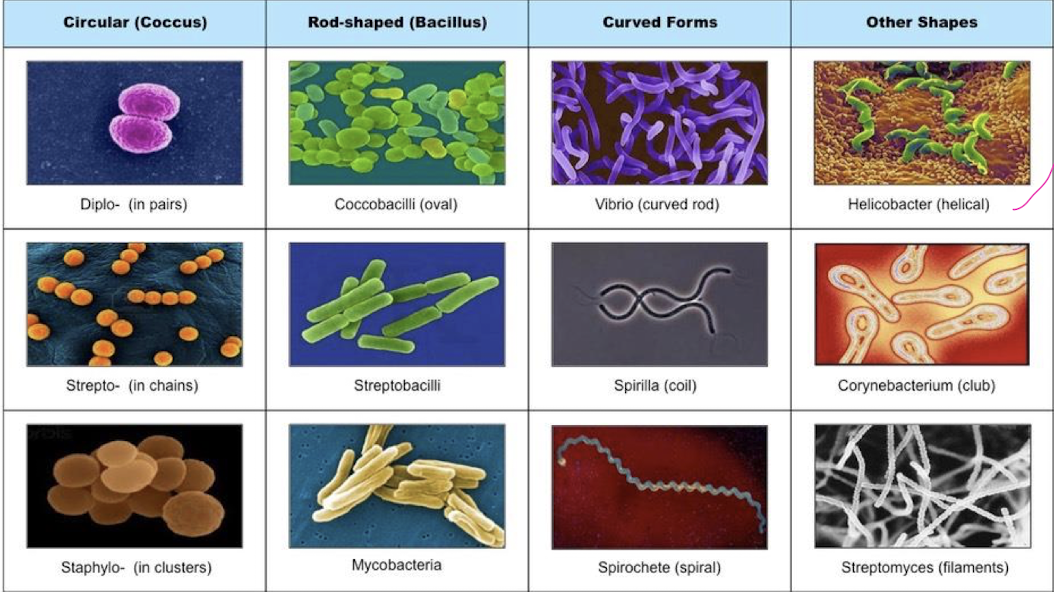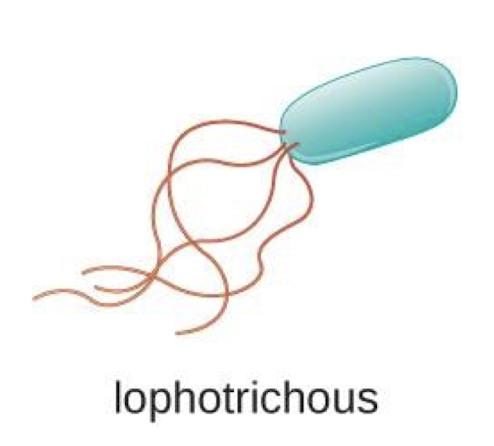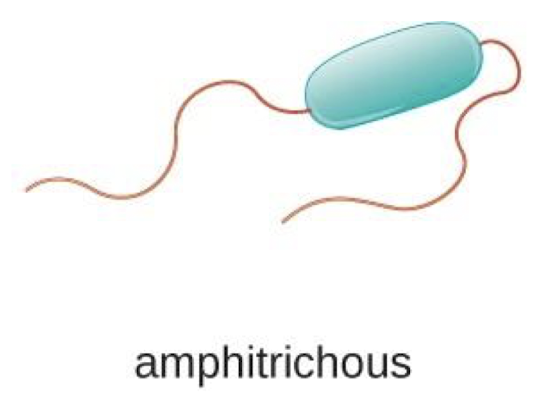Bacterial Morphology
1/62
Earn XP
Description and Tags
Exam 1 - Lec 2 - Intro to Bacterial Cell Architecture
Name | Mastery | Learn | Test | Matching | Spaced |
|---|
No study sessions yet.
63 Terms
What is the key difference between prokaryotes and eukaryotes?
eukaryotes are very complex:
nucleus + lots of other organelles
multiple linear chromosomes
replication (nucleus), transcription (nucleus), & translation (cytoplasm) happen separately
prokaryotes are simple:
NO defined nucleus (or other membrane-enclosed organelles)
single circular chromosome
replication, transcription, & translation happen simultaneously → rapid growth & adaptability
What specific cellular characteristics do bacteria possess that eukaryotes do not?
Bacteria:
peptidoglycan, 70S ribosomes, 1 RNA polymerase (5 subunits)
Eukaryotes:
NO peptidoglycan, 80S ribosomes, 3 RNA polymerases (12-14 subunits)
Why is it important to understand the different structural characteristics of bacteria and eukaryotes?
helps vets pick drugs that target bacteria but NOT eukaryotes
T/F: Prokaryotes possess NO internal structures.
FALSE - no nucleus/ organelles but do have many internal structures
(thylakoid membranes for photosynthesis, carboxysomes for CO2 fixation, ect)
T/F: Prokaryotes have vast organismal diversity.
TRUE - largest biomass of living organisms
What factors contribute to prokaryote organismal diversity?
Nutritional versatility:
can digest carbs, hydrocarbons, organic acids, etc
Metabolic diversity:
N fixation, sulfur reduction/oxidation (different e- acceptors), photosynthesis, etc
What are the 8 defining characteristics of prokaryotic cells?
Lack of nucleus → chromosome localized in nucleoid
Complex cell wall → rigid support, protects from turgor pressure
Simple internal structure → no membrane-bound organelles
Single circular chromosome
Asexual reproduction → binary fission = quick (exponential) population growth
Size and scale → 0.1-5 micrometers (much smaller than eucarya)
Metabolic diversity → utilize MANY energy sources, highly adaptable & survives anywhere
Genetic adaptability → rapidly adapts through mutations, horizontal gene transfer
What are the 3 common bacterial shapes?
Cocci → spherical
Bacilli → rod-shaped
Spirilla → spiral-shaped
Cocci are _______ in shape and can appear in ______ or ______.
spherical
clusters
chains
T/F: Bacilli can be found in various environments.
TRUE - so many spp (E. coli, Clostridium spp, B. anthracis, Salmonella spp)
What are some common cocci species?
Staphylococcus aureus (mastitis, skin infections)
Staphylococcus intermedius (skin & ear infections)
Streptococcus agalactiae (subclinical mastitis)
Streptococcus suis (meningitis, arthritis in swine)
Spirilla are _______ in shape and often ______.
spiral
motile
The unique shape of Spirilla aids in their _________.
locomotion
What are some common Spirilla species?
Leptospira spp
Borrelia burgdorferi (Lyme disease)
T/F: The shape and structure of bacteria are not imperative for identifying the type of infection.
FALSE
What are some common bacterial arrangements?
staphylococcus (clusters)
diplococci (pairs)
streptobacilli (chains)

Why is understanding the different cellular components of bacteria essential for veterinarians?
directly informs diagnosis, treatment, and prevention of bacterial infections
What do structures such as cell walls, membranes, capsules, pili, and flagella do for bacteria?
influence their ability to cause disease, evade the immune system, and resist antibiotics → important in determining virulence
Awarness of bacterial cell structure supports effective _________ & _________, therefore helping vets protect both animal and __________.
biosecurity practices
vaccine strategies
public health
Flagella are __________ structures primarily used for _________ in _________ habitats.
tail-like
motility
aqueous
Aside from motility, what other purposes do flagella serve?
adhesion & host-cell invasion
Flagella allow bacteria to perform _________.
chemotaxis
What is chemotaxis?
movement toward an attractant (nutrients) or away from a repellent
T/F: Production of flagella is extremely easy and energy sparing for bacteria.
FALSE - extremely energetically expensive (grow 2% more slowly)
Monotrichous
1 flagellum

Peritrichous
flagellum all over the surface

Lophotrichous
flagella in clumps (bundled)

Amphitrichous
one flagellum at both ends

Polar flagella normally assist with ________ while lateral flagella normally assist with __________.
chemotaxis
adherence
Flagella are made up of ______ parts.
3
What are the 3 parts of flagella?
Basal body (anchored in cell wall)
Filament (the “tail”)
Hook (connects filament to the cell)
The filament is comprised of individual protein subunits called ________.
flagellin (also called H-antigen in sterotyping)
T/F: Flagellins are highly immunogenic.
TRUE - one of the most recognizable bacterial proteins by host immune system (used a lot for vaccines)
Some bacteria (Salmonella enterica) use ________ to randomly switch between different types of flagellin proteins.
phase variation
What is the purpose of phase variation?
to avoid immune detection → “disguise itself”
Flagellar motor consists of _________ which turns ___________ by default.
plain filaments
counterclockwise
What does counterclockwise rotation of plain filaments do for the cell?
allows several peritrichous flagella to bundle together and propel the cell smoothly forward
T/F: Complex filaments can only rotate clockwise.
TRUE - though much less common
What signals the flagellar motor to switch to a clockwise rotation?
chemotaxis signaling molecule
What is the result of flagellar motors switching to clockwise rotation?
dissociation of pertitrichous flagellar bundle, resulting in a “tumble” → reorientation of the cell
What is tactic response?
the ability to move in response to environmental stimuli (sensory control of swimming behavior)
Environmental change is sensed by a sensory protein, generally ________ sensing the __________ environment.
transmembrane proteins
external (some spp may have additional cytoplasmic receptors)
What are examples of different tactic responses?
Chemotaxis → chemical stimuli
Phototaxis → light stimulus
Aerotaxis → oxygen
Magnetotaxis → magnetic field
What are the 2 important consideration of the tactic response?
Length of run
Direction of run
Bacteria measure the _________ over time.
chemoeffector
If bacteria sense a/an __________, tumble frequency _________.
attractant
decreases (runs are longer)
If bacteria senses a/an ___________, tumble frequency _________.
repellent
increases (runs are shorter)
Spirochetes have ________ flagella.
internal
Where is the flagella of spircochetes located?
in the periplasm between inner & outer membrane → periplasmic flagella
How are flagella oriented within spirochetes?
wrap around the length of the cell and overlap in the middle
Rotation of axial filaments of spirochetes creates ____________.
“cork-screw” movement
The ability of spirochetes to swim using cork-screw movement allows the pathogen to be ___________ and __________ in human/animal hosts.
highly invasive
virulent
Pili are also called _______.
fimbriae
What are pili?
protein filaments on the cell surface
Pili are _________, ___________, and __________ than a flagellum.
shorter, straighter, more fragile
T/F: Pili are usually present in low numbers on the surface of bacteria.
FALSE - large numbers
Pili are found almost exclusively in which type of bacteria?
Gram negative
Pili mediate various functions including:
Adhesion
Conjugation (sex pili)
Twitchin motility & social motility (Type IV pili)
Phage receptor
Like flagellum, pili are also _________.
immunogenic
What type of pili are used for adhesion?
type I
Pili are important ________ factors.
colonization (virulence factors involved in colonization & invasion portion of disease)
T/F: Pili are NOT produced are initial colonization.
TRUE
Adhesion is mediated by proteins located at the tip of the pili called
adhesins